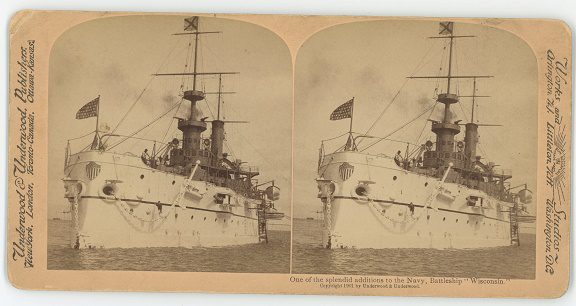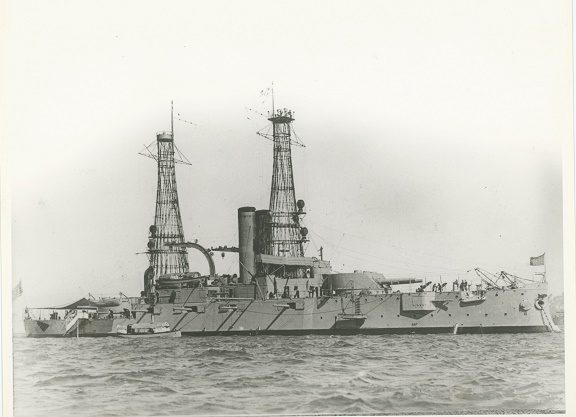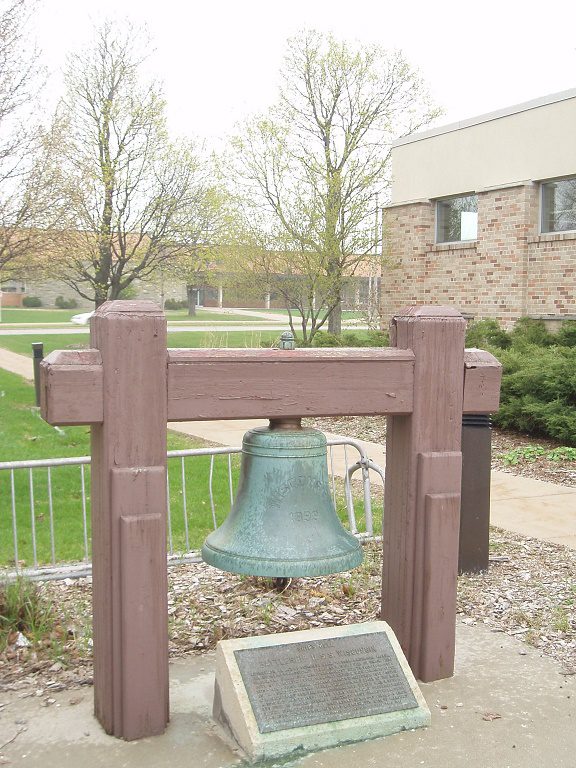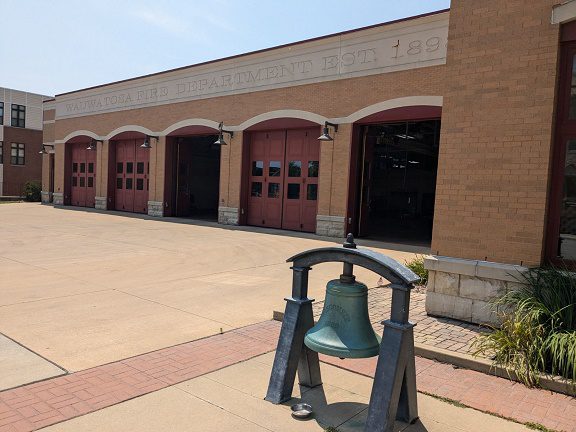By James Heinz
Nautical, maritime, and naval artifacts from ships long gone are usually found near the water, like the old ship’s anchor next to Lake Michigan in South Shore Park, or the propeller from the SS BADGER at the Port Washington marina, both of which I recently profiled. But this is a story about such an artifact that is far from the any body of water large enough to float a ship.
It is in the suburbs of Milwaukee, 15 miles from Lake Michigan.
WMHS member and former lake ship captain Greg Stamatelakys brought this to my attention on the same day I achieved Hollywood stardom aboard the USS COBIA at the Wisconsin Maritime Museum in Manitowoc.

The ship in question is the USS WISCONSIN. Most marine history buffs are familiar with the battleship USS WISCONSIN, which was launched and served in World War II and also served in Korea and Gulf War I. That ship, which was USS WISCONSIN #2, is now permanently moored as a museum ship in Norfolk VA.
But many readers may not be familiar with the first USS WISCONSIN. And it is an artifact of hers that is now on display in front of the Wauwatosa (Wisconsin) Fire Department. It is the ship’s bell. This is the story of the ship it came from and how its bell got so far from navigable water.
WMHS files show that the first USS Wisconsin (BB-9) was launched on November 26, 1898, in San Francisco, California. She was an IILLINOIS class pre-dreadnought battleship.
What is a “pre-dreadnought” battleship? Appropriately enough, a pre-dreadnought battleship is a battleship that was launched before the British battleship HMS DREADNOUGHT was launched in 1906. The British ship was considered so revolutionary that all battleships are classified as pre or post dreadnoughts.
USS WISCONSIN #1 was 368 feet long, 72 feet wide, and displaced 12,250 long tons. She had 8 boilers that supplied steam to two vertical triple expansion engines providing over 12,000 horsepower driving two propellers to a top speed of 16 knots.

Unlike most of the ships I profile on this blog, she was heavily armed, with four 13 inch (330mm) guns in two twin turrets fore and aft, fourteen 6 inch (152mm) guns in casemates along both her sides, sixteen 57 mm guns and six 37 mm guns, as well as four 18 inch torpedo guns. Not too many Lake freighters packed that kind of heat.
She could not only dish it out, she could take it. She carried 14 inches of armor on her turrets, 10 inches of armor on her conning tower, and four inches of belt armor along her side.
USS WISCONSIN #1 spent much of her time in routine training duties and “showing the flag” abroad. Her most famous flag showing moment came when she was part of “The Great White Fleet”.
Wikipedia tells us: “The Great White Fleet was the popular nickname for the group of United States Navy battleships that completed a journey around the globe from December 16, 1907 to February 22, 1909, by order of President Theodore Roosevelt. It consisted of 16 battleships divided into two squadrons, and earned its moniker for the stark white paint on its hulls.”
“The fleet’s primary mission was to make friendly courtesy visits to numerous countries while displaying new U.S. naval power to the world; Roosevelt sought to demonstrate growing American military prowess and blue-water naval capabilities.”
Oddly enough for a vessel of war, her greatest achievement was to promote peace. In 1902 she helped end the Thousand Day War between competing factions in Colombia. Although South American political unrest usually did not then result in mass casualties, the Thousand Day War cost the lives of about three percent of the population of Colombia, or somewhere between 100,000 to 180,000 lives.
Diplomatic intervention and pressure by President Roosevelt resulted in a peace treaty between the two factions being negotiated for several months and then signed on November 21, 1902, aboard the USS WISCONSIN #1. This caused the treaty to be known as “The peace of the WISCONSIN” in Colombia.
In 1913 the ship was taken out of active service and served as a training ship for the rest of her career. As a result of the reduction in worldwide naval fleets required by the Washington Naval Treaty of 1920, USS WISCONSIN was sold for scrap in 1922.
So how did her bell end up in Wauwatosa?
According to a May 1, 2010, Milwaukee Journal article, after the ship was scrapped, Tosa native and East Coast railroad tycoon Frederick Underwood bought it and donated it to the Wauwatosa Fire Department. He did not, as you might think, donate it as a memorial to the American armed forces.
In an early example of recycling, the bell was used to summon volunteer firefighters to emergencies.
The bell hung in the tower of the original Wauwatosa Fire Dept. station until the station closed in 1942. It then was put in storage until 1960 when it was placed outside the Wauwatosa Civic Center in a place where hardly anyone ever saw it. One person who did see it objected to the bell being placed in such an obscure location. Who was this person?
Our own Captain Greg Stamatelakys.

U.S. Navy veteran and ship captain, Captain Greg voiced his objections to Wauwatosa city officials. He felt that the bell should be in a more appropriate place, like the state capitol building, or the War Memorial on the lakefront, which would at least be close to a large body of water. Right now, the closest body of water to the bell is the Menomonee River, which is barely deep enough to float a rubber duck.
The reactions of Wauwatosa city officials can best be described as unsympathetic. One official remarked that the War Memorial already has one bell from USS MILWAUKEE #2, and apparently felt that was enough bells for one building. Other officials responded thusly: “It just ain’t gonna happen” and “They’d have to pry it from our hands.” So much for government officials never giving a straight answer.

And so, the bell remains in front of the Wauwatosa Fire Department station at 1601 Underwood Avenue. Far from the sea, but now far from forgotten, a memorial to a warship that made peace.
(P.S. WMHS files show that the ship’s four foot high brass wheel was donated to the City of Janesville in 1922. A person who contacted WMHS about the bell in 2022 reported that Janesville officials had no idea what happened to the wheel. If you know what happened to it, please let us know.)
____________________________________
James Heinz is the Wisconsin Marine Historical Society’s acquisitions director. He became interested in maritime history as a kid watching Jacques Cousteau’s adventures on TV. He was a Great Lakes wreck diver until three episodes of the bends forced him to retire from diving. He was a University of Wisconsin – Milwaukee police officer for thirty years. He regularly flies either a Cessna 152 or 172.
PHOTOS:
USS WISCONSIN Bell outside the Wauwatosa Fire Department, 2024. Photo by Jim Heinz
Stereoscopic photo of USS WISCONSIN BB-9 built 1901. Great Lakes Marine Collection of the Milwaukee Public Library and Wisconsin Marine Historical Society
USS WISCONSIN BB-9 built 1901. Great Lakes Marine Collection of the Milwaukee Public Library and Wisconsin Marine Historical Society
USS WISCONSIN Bell outside the Wauwatosa Civic Center, 2001. Photo by Greg Stamatelakys.
USS WISCONSIN Bell outside the Wauwatosa Fire Department, 2024. Photo by Jim Heinz

